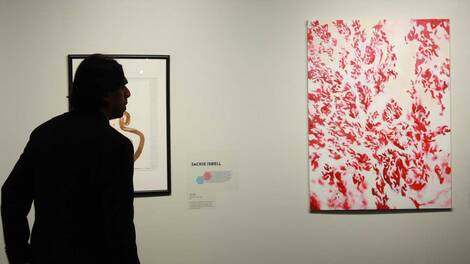
Special Issue
CRASE
Bright Future or Cautionary Tale? How the Bay Area Shapes the Future of the U.S.
A New Model of Art Commerce

In the 2010s, art galleries in San Francisco were struggling and many had to close due to an upsurge in tech startups that were driving up commercial rent prices in the city. The model of the brick-and-mortar art gallery was not prevailing in these changing conditions. Worse still, artists were losing their studios—often housed in commercial spaces without rent control protections—and were forced to move out of town. San Francisco was becoming a boomtown, but for those in the art world, these economic forces were undermining the sustainability of the business model. The Minnesota Street Project provided an alternative for the art world that is applicable to other industries facing challenges due to disruptions caused by the market and gentrification of urban areas around the country.
The Minnesota Street Project is the brainchild of Deborah and Andy Rappaport. In 2014, they met with the San Francisco Art Dealers Association and proposed an alternative solution for art galleries: find a larger space where they could move in together and collectivize some of their activities, leading to lower overall business expenses but especially below-market level rent. The dealers present were excited about the idea and five signed up on the spot. By the end of the year, the Rappaports bought warehouse spaces in a neighborhood called the Dogpatch that was rapidly transforming from a light and heavy industrial area to a bedroom community. This neighborhood was a financially viable alternative to the pricier Mission district nearby, and by 2016, the first building of three opened to the public.
The crisis experienced by the Bay Area art community was a threat to the entire ecosystem: not only commercial galleries, but artists and nonprofits also needed a new model to sustain themselves. As Silicon Valley entrepreneurs and art collectors, the Rappaports were invested in the art world but saw the opportunity to develop a new and workable model. While tech entrepreneurs have started foundations aplenty, few had engaged the arts community. As author Manuel Pastor argues in State of Resistance, change in California has not been solely the result of well-placed individuals like Governor Jerry Brown but also due to collective action.
In the case of the Minnesota Street Project, the Rappaports worked with gallerists and artists in the community to realize their vision for the art community. They transformed these warehouses into gallery and studio spaces, as well as art warehousing and shipping spaces to support the galleries and visiting exhibition projects. This philanthropic enterprise is neither a traditional nonprofit nor a commercial structure but draws on elements of both. While it operates as a business, it returns all of its profits back into the services it provides as nonprofits do, thereby creating a subsidized rent situation for galleries and artists.
The results are evident. There was no problem recruiting galleries for the first building to open at 1275 Minnesota Street. Several of the city’s longstanding galleries, such as Anglim Gilbert Gallery and Rena Bransten Gallery, decamped their Financial District locations to move in, shoulder to shoulder with their peers. Newer galleries that bring younger audiences, such as Ever Gold [Projects] and Bass & Reiner also moved in and new enterprises, such as Casemore Kirkeby were launched in the space. They also provide space for the San Francisco Arts Education Project, which has engaged more than 250,000 public school students in San Francisco to experience art close up. At the public opening in March 2016, the line to get in stretched around the building because it was full to capacity from the first minutes it was opened.
A building of artists’ studios opened across the street soon thereafter. The application process insures diversity among the studio holders and the space provided facilities, such as photo printers, a darkroom and a kiln that the studio-holders use collectively. These studios are rented at subsidized prices and there is an “open-studio” event held annually that attracts hundreds of visitors. The number of studios is quite limited, however, so this aspect of the organization is more exclusive, but it demonstrates their understanding of the arts ecosystem that they constructed both gallery and studio buildings for collective use. A third building houses more galleries and the McEvoy Foundation for the Arts, as well as art storage. This building also houses art services, providing collectors and galleries with shipping and installation capacities but also generating profits that sustain the overall project. According to Julie Casemore, the Director of Minnesota Street Project and a gallerist there, most of the dealers have seen “success beyond expectations” in the first two years.
The most exciting aspect of this enterprise is that it has generated a new model for art commerce that engages the entire system of artists, galleries, nonprofits and collectors in an organization that is neither a nonprofit nor a traditional business but a blend of both. This innovation suggests multiple possibilities for innovation to redistribute, rescale, or refurbish existing commercial models that are challenged by e-commerce, gentrification, or other disruptive economic forces in the current market-dominated climate. As the United States grapples with the disappearance of toy stores, travel agents, music venues, and booksellers, the Minnesota Street Project offers a model to collectivize commercial activity, gather enthusiasts, and offer special events that attract and engage the broader public.
 John Zarobell is Associate Professor and Chair of International Studies at USF. His art criticism has appeared in Artsy, Art Practical and the San Francisco Art Quarterly and his book, Art and the Global Economy, was published by UC Press in 2017.
John Zarobell is Associate Professor and Chair of International Studies at USF. His art criticism has appeared in Artsy, Art Practical and the San Francisco Art Quarterly and his book, Art and the Global Economy, was published by UC Press in 2017.